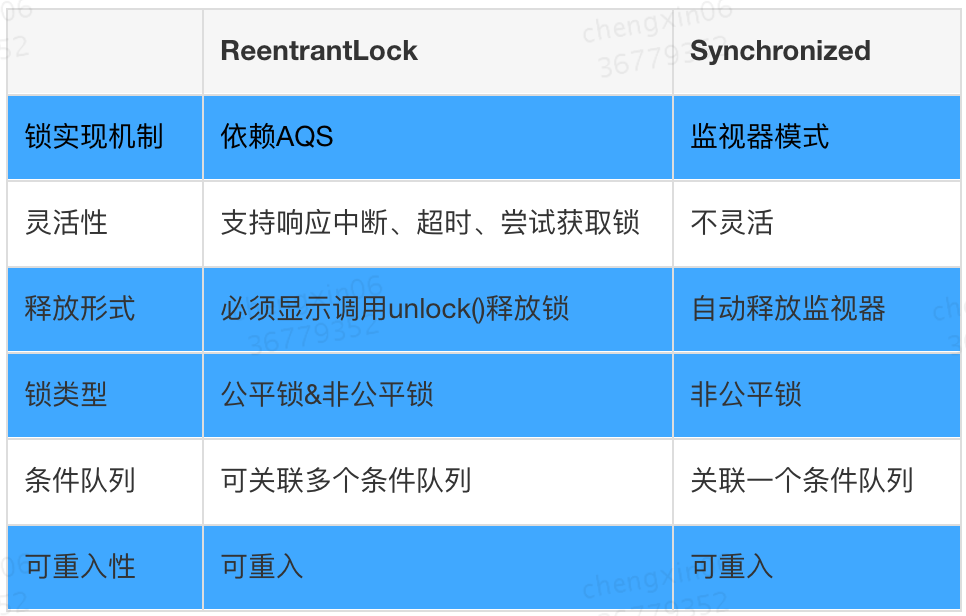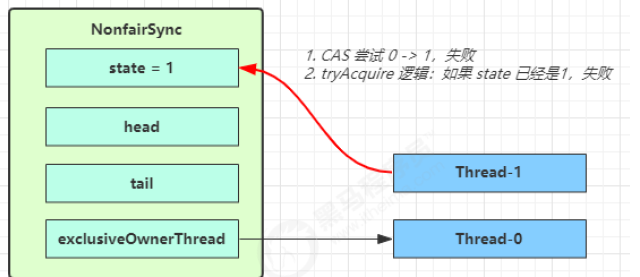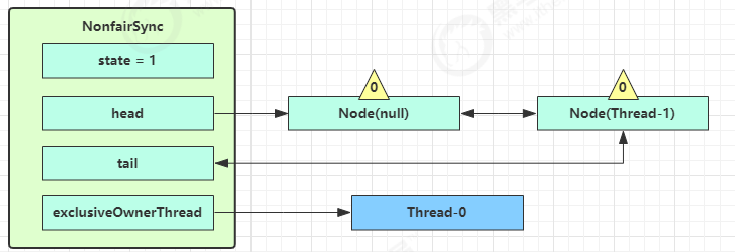ReentrantLock
ReentrantLock
2. * ReentrantLock 原理・语雀 (yuque.com)
从 ReentrantLock 的实现看 AQS 的原理及应用 - 美团技术团队 (meituan.com)
锁对比
ReentrantLock 相对于 synchronized 具备如下特点:
锁的实现:synchronized 是 JVM 实现的,而 ReentrantLock 是 JDK 实现的
性能:新版本 Java 对 synchronized 进行了很多优化,synchronized 与 ReentrantLock 大致相同
使用:ReentrantLock 需要手动解锁,synchronized 执行完代码块自动解锁
可中断:ReentrantLock 可中断,而 synchronized 不行
公平锁
:公平锁是指多个线程在等待同一个锁时,必须按照申请锁的时间顺序来依次获得锁
- ReentrantLock 可以设置公平锁,synchronized 中的锁是非公平的
- 不公平锁的含义是阻塞队列内公平,队列外非公平
锁超时:尝试获取锁,超时获取不到直接放弃,不进入阻塞队列
- ReentrantLock 可以设置超时时间,synchronized 会一直等待
锁绑定多个条件:一个 ReentrantLock 可以同时绑定多个 Condition 对象,更细粒度的唤醒线程
两者都是可重入锁
可重入
可重入是指同一个线程如果首次获得了这把锁,那么它是这把锁的拥有者,因此有权利再次获取这把锁,如果不可重入锁,那么第二次获得锁时,自己也会被锁挡住,直接造成死锁
1 |
|
输出:
1 |
|
在 Lock 方法加两把锁会是什么情况呢?
- 加锁两次解锁两次:正常执行
- 加锁两次解锁一次:程序直接卡死,线程不能出来,也就说明申请几把锁,最后需要解除几把锁
- 加锁一次解锁两次:运行程序会直接报错
1 |
|
可打断
基本使用
public void lockInterruptibly():获得可打断的锁
- 如果没有竞争此方法就会获取 lock 对象锁
- 如果有竞争就进入阻塞队列,可以被其他线程用 interrupt 打断
1 |
|
注意:如果是不可中断模式,那么即使使用了 interrupt 也不会让等待状态中的线程中断
实现原理
不可打断模式:即使它被打断,仍会驻留在 AQS 阻塞队列中,一直要等到获得锁后才能得知自己被打断了
1
2
3
4
5
6
7
8
9
10
public final void acquire(int arg) {
if (!tryAcquire(arg) && acquireQueued(addWaiter(Node.EXCLUSIVE), arg))//阻塞等待
// 如果acquireQueued返回true,打断状态 interrupted = true
selfInterrupt();
}
static void selfInterrupt() {
// 知道自己被打断了,需要重新产生一次中断完成中断效果
Thread.currentThread().interrupt();
}1
2
3
4
5
6
7
8
9
10
11
12
13
14
15
16
17
18
19
20
21
22
23
24
25
26
27
28
29
final boolean acquireQueued(final Node node, int arg) {
try {
boolean interrupted = false;
for (;;) {
final Node p = node.predecessor();
if (p == head && tryAcquire(arg)) {
setHead(node);
p.next = null; // help GC
failed = false;
// 还是需要获得锁后, 才能返回打断状态
return interrupted;
}
if (shouldParkAfterFailedAcquire(p, node) && parkAndCheckInterrupt()){
// 条件二中判断当前线程是否被打断,被打断返回true,设置中断标记为 true,【获取锁后返回】
interrupted = true;
}
}
} finally {
if (failed)
cancelAcquire(node);
}
}
private final boolean parkAndCheckInterrupt() {
// 阻塞当前线程,如果打断标记已经是 true, 则 park 会失效
LockSupport.park(this);
// 判断当前线程是否被打断,清除打断标记,被打断返回true
return Thread.interrupted();
}可打断模式:AbstractQueuedSynchronizer#acquireInterruptibly,被打断后会直接抛出异常
1
2
3
4
5
6
7
8
9
10
11
12
public void lockInterruptibly() throws InterruptedException {
sync.acquireInterruptibly(1);
}
public final void acquireInterruptibly(int arg) {
// 被其他线程打断了直接返回 false
if (Thread.interrupted())
throw new InterruptedException();
if (!tryAcquire(arg))
// 没获取到锁,进入这里
doAcquireInterruptibly(arg);
}1
2
3
4
5
6
7
8
9
10
11
12
13
14
15
16
17
18
19
private void doAcquireInterruptibly(int arg) throws InterruptedException {
// 返回封装当前线程的节点
final Node node = addWaiter(Node.EXCLUSIVE);
boolean failed = true;
try {
for (;;) {
//...
if (shouldParkAfterFailedAcquire(p, node) && parkAndCheckInterrupt())
// 【在 park 过程中如果被 interrupt 会抛出异常】, 而不会再次进入循环获取锁后才完成打断效果
throw new InterruptedException();
}
} finally {
// 抛出异常前会进入这里
if (failed)
// 取消当前线程的节点
cancelAcquire(node);
}
}1
2
3
4
5
6
7
8
9
10
11
12
13
14
15
16
17
18
19
20
21
22
23
24
25
26
27
28
29
30
31
32
33
34
35
36
37
38
39
40
41
42
43
44
45
46
47
48
// 取消节点出队的逻辑
private void cancelAcquire(Node node) {
// 判空
if (node == null)
return;
// 把当前节点封装的 Thread 置为空
node.thread = null;
// 获取当前取消的 node 的前驱节点
Node pred = node.prev;
// 前驱节点也被取消了,循环找到前面最近的没被取消的节点
while (pred.waitStatus > 0)
node.prev = pred = pred.prev;
// 获取前驱节点的后继节点,可能是当前 node,也可能是 waitStatus > 0 的节点
Node predNext = pred.next;
// 把当前节点的状态设置为 【取消状态 1】
node.waitStatus = Node.CANCELLED;
// 条件成立说明当前节点是尾节点,把当前节点的前驱节点设置为尾节点
if (node == tail && compareAndSetTail(node, pred)) {
// 把前驱节点的后继节点置空,这里直接把所有的取消节点出队
compareAndSetNext(pred, predNext, null);
} else {
// 说明当前节点不是 tail 节点
int ws;
// 条件一成立说明当前节点不是 head.next 节点
if (pred != head &&
// 判断前驱节点的状态是不是 -1,不成立说明前驱状态可能是 0 或者刚被其他线程取消排队了
((ws = pred.waitStatus) == Node.SIGNAL ||
// 如果状态不是 -1,设置前驱节点的状态为 -1
(ws <= 0 && compareAndSetWaitStatus(pred, ws, Node.SIGNAL))) &&
// 前驱节点的线程不为null
pred.thread != null) {
Node next = node.next;
// 当前节点的后继节点是正常节点
if (next != null && next.waitStatus <= 0)
// 把 前驱节点的后继节点 设置为 当前节点的后继节点,【从队列中删除了当前节点】
compareAndSetNext(pred, predNext, next);
} else {
// 当前节点是 head.next 节点,唤醒当前节点的后继节点
unparkSuccessor(node);
}
node.next = node; // help GC
}
}
锁超时
基本使用
public boolean tryLock():尝试获取锁,获取到返回 true,获取不到直接放弃,不进入阻塞队列
public boolean tryLock(long timeout, TimeUnit unit):在给定时间内获取锁,获取不到就退出
注意:tryLock 期间也可以被打断
1 |
|
实现原理
成员变量:指定超时限制的阈值,小于该值的线程不会被挂起
1
2
static final long spinForTimeoutThreshold = 1000L;超时时间设置的小于该值,就会被禁止挂起,因为阻塞在唤醒的成本太高,不如选择自旋空转
tryLock()
1
2
3
4
5
public boolean tryLock() {
// 只尝试一次
return sync.nonfairTryAcquire(1);
}tryLock(long timeout, TimeUnit unit)
1
2
3
4
5
6
7
8
9
10
public final boolean tryAcquireNanos(int arg, long nanosTimeout) {
if (Thread.interrupted())
throw new InterruptedException();
// tryAcquire 尝试一次
return tryAcquire(arg) || doAcquireNanos(arg, nanosTimeout);
}
protected final boolean tryAcquire(int acquires) {
return nonfairTryAcquire(acquires);
}1
2
3
4
5
6
7
8
9
10
11
12
13
14
15
16
17
18
19
20
21
22
23
24
private boolean doAcquireNanos(int arg, long nanosTimeout) {
if (nanosTimeout <= 0L)
return false;
// 获取最后期限的时间戳
final long deadline = System.nanoTime() + nanosTimeout;
//...
try {
for (;;) {
//...
// 计算还需等待的时间
nanosTimeout = deadline - System.nanoTime();
if (nanosTimeout <= 0L) //时间已到
return false;
if (shouldParkAfterFailedAcquire(p, node) &&
// 如果 nanosTimeout 大于该值,才有阻塞的意义,否则直接自旋会好点
nanosTimeout > spinForTimeoutThreshold)
LockSupport.parkNanos(this, nanosTimeout);
// 【被打断会报异常】
if (Thread.interrupted())
throw new InterruptedException();
}
}
}
5 名哲学家,5 根筷子,哲学家左右两边的筷子跟身边的人共享,只有同时拿起左手的筷子和右手的筷子,哲学家才可以夹菜。
这个问题其实是一个
死锁问题。
当 0 号拿着 a 筷子的时候,它需要申请 b 这根筷子,才可以夹菜,但 b 这根筷子在被 1 号使用着,因此 0 号无法夹菜,这时候怎么办,需要等 1 号吃完,把 b 筷子放手,而 1 号想夹菜则需要申请 c 这根筷子,但 c 这根筷子又被 2 号使用着,所以每名哲学家左手都拿着筷子,而右手的筷子都在被使用中,形成了一个死锁环。
用 ReentrantLock 解决哲学家就餐问题
让 class Chopsticks extends ReentrantLock 用 trylock 试图获取锁,如果无法获取则最后释放锁(可以让别人拿到锁)。
1 |
|
(可设置是否为) 公平锁
公平:先来就能先执行
不公平:不保证先来就先执行
基本使用
构造方法:ReentrantLock lock = new ReentrantLock(true)
1 |
|
ReentrantLock 默认是不公平的:
1 |
|
说明:公平锁一般没有必要,会降低并发度
非公原理
加锁
NonfairSync 继承自 AQS
1 |
|
没有竞争:ExclusiveOwnerThread 属于 Thread-0,state 设置为 1
1
2
3
4
5
6
7
8
9
10
// ReentrantLock.NonfairSync#lock
final void lock() {
// 用 cas 尝试(仅尝试一次)将 state 从 0 改为 1, 如果成功表示【获得了独占锁】
if (compareAndSetState(0, 1))
// 设置当前线程为独占线程
setExclusiveOwnerThread(Thread.currentThread());
else
acquire(1);//失败进入
}第一个竞争出现:Thread-1 执行,CAS 尝试将 state 由 0 改为 1,结果失败(第一次),进入 acquire 逻辑
1
2
3
4
5
6
7
8
9
// AbstractQueuedSynchronizer#acquire
public final void acquire(int arg) {
// tryAcquire 尝试获取锁失败时, 会调用 addWaiter 将当前线程封装成node入队,acquireQueued 阻塞当前线程,
// acquireQueued 返回 true 表示挂起过程中线程被中断唤醒过,false 表示未被中断过
if (!tryAcquire(arg) && acquireQueued(addWaiter(Node.EXCLUSIVE), arg))
// 如果线程被中断了逻辑来到这,完成一次真正的打断效果
selfInterrupt();
}
进入 tryAcquire 尝试获取锁逻辑,这时 state 已经是 1,结果仍然失败(第二次),加锁成功有两种情况:
- 当前 AQS 处于无锁状态
- 加锁线程就是当前线程,说明发生了锁重入
1
2
3
4
5
6
7
8
9
10
11
12
13
14
15
16
17
18
19
20
21
22
23
24
25
26
27
28
29
30
31
32
33
// ReentrantLock.NonfairSync#tryAcquire
protected final boolean tryAcquire(int acquires) {
return nonfairTryAcquire(acquires);
}
// 抢占成功返回 true,抢占失败返回 false
final boolean nonfairTryAcquire(int acquires) {
final Thread current = Thread.currentThread();
// state 值
int c = getState();
// 条件成立说明当前处于【无锁状态】
if (c == 0) {
//如果还没有获得锁,尝试用cas获得,这里体现非公平性: 不去检查 AQS 队列是否有阻塞线程直接获取锁
if (compareAndSetState(0, acquires)) {
// 获取锁成功设置当前线程为独占锁线程。
setExclusiveOwnerThread(current);
return true;
}
}
// 如果已经有线程获得了锁, 独占锁线程还是当前线程, 表示【发生了锁重入】
else if (current == getExclusiveOwnerThread()) {
// 更新锁重入的值
int nextc = c + acquires;
// 越界判断,当重入的深度很深时,会导致 nextc < 0,int值达到最大之后再 + 1 变负数
if (nextc < 0) // overflow
throw new Error("Maximum lock count exceeded");
// 更新 state 的值,这里不使用 cas 是因为当前线程正在持有锁,所以这里的操作相当于在一个管程内
setState(nextc);
return true;
}
// 获取失败
return false;
}接下来进入 addWaiter 逻辑,构造 Node 队列,前置条件是当前线程获取锁失败,说明有线程占用了锁
- 图中黄色三角表示该 Node 的 waitStatus 状态,其中 0 为默认正常状态
- Node 的创建是懒惰的,其中第一个 Node 称为 Dummy(哑元)或哨兵,用来占位,并不关联线程
1
2
3
4
5
6
7
8
9
10
11
12
13
14
15
16
17
18
19
20
// AbstractQueuedSynchronizer#addWaiter,返回当前线程的 node 节点
private Node addWaiter(Node mode) {
// 将当前线程关联到一个 Node 对象上, 模式为独占模式
Node node = new Node(Thread.currentThread(), mode);
Node pred = tail;
// 快速入队,如果 tail 不为 null,说明存在阻塞队列
if (pred != null) {
// 将当前节点的前驱节点指向 尾节点
node.prev = pred;
// 通过 cas 将 Node 对象加入 AQS 队列,成为尾节点,【尾插法】
if (compareAndSetTail(pred, node)) {
pred.next = node;// 双向链表
return node;
}
}
// 初始时队列为空,或者 CAS 失败进入这里
enq(node);
return node;
}1
2
3
4
5
6
7
8
9
10
11
12
13
14
15
16
17
18
19
20
21
22
23
// AbstractQueuedSynchronizer#enq
private Node enq(final Node node) {
// 自旋入队,必须入队成功才结束循环
for (;;) {
Node t = tail;
// 说明当前锁被占用,且当前线程可能是【第一个获取锁失败】的线程,【还没有建立队列】
if (t == null) {
// 设置一个【哑元节点】,头尾指针都指向该节点
if (compareAndSetHead(new Node()))
tail = head;
} else {
// 自旋到这,普通入队方式,首先赋值尾节点的前驱节点【尾插法】
node.prev = t;
// 【在设置完尾节点后,才更新的原始尾节点的后继节点,所以此时从前往后遍历会丢失尾节点】
if (compareAndSetTail(t, node)) {
//【此时 t.next = null,并且这里已经 CAS 结束,线程并不是安全的】
t.next = node;
return t; // 返回当前 node 的前驱节点
}
}
}
}线程节点加入阻塞队列成功,进入 AbstractQueuedSynchronizer#acquireQueued 逻辑阻塞线程
- acquireQueued 会在一个自旋中不断尝试获得锁,失败后进入 park 阻塞
- 如果当前线程是在 head 节点后,会再次 tryAcquire 尝试获取锁,state 仍为 1 则失败(第三次)
1
2
3
4
5
6
7
8
9
10
11
12
13
14
15
16
17
18
19
20
21
22
23
24
25
26
27
28
29
30
31
32
final boolean acquireQueued(final Node node, int arg) {
// true 表示当前线程抢占锁失败,false 表示成功
boolean failed = true;
try {
// 中断标记,表示当前线程是否被中断
boolean interrupted = false;
for (;;) {
// 获得当前线程节点的前驱节点
final Node p = node.predecessor();
// 前驱节点是 head, FIFO 队列的特性表示轮到当前线程可以去获取锁
if (p == head && tryAcquire(arg)) {
// 获取成功, 设置当前线程自己的 node 为 head
setHead(node);
p.next = null; // help GC
// 表示抢占锁成功
failed = false;
// 返回当前线程是否被中断
return interrupted;
}
// 判断是否应当 park,返回 false 后需要新一轮的循环,返回 true 进入条件二阻塞线程
if (shouldParkAfterFailedAcquire(p, node) && parkAndCheckInterrupt())
// 条件二返回结果是当前线程是否被打断,没有被打断返回 false 不进入这里的逻辑
// 【就算被打断了,也会继续循环,并不会返回】
interrupted = true;
}
} finally {
// 【可打断模式下才会进入该逻辑】
if (failed)
cancelAcquire(node);
}
}- 进入 shouldParkAfterFailedAcquire 逻辑,将前驱 node 的 waitStatus 改为 -1,返回 false;waitStatus 为 -1 的节点用来唤醒下一个节点
1
2
3
4
5
6
7
8
9
10
11
12
13
14
15
16
17
18
19
20
21
private static boolean shouldParkAfterFailedAcquire(Node pred, Node node) {
int ws = pred.waitStatus;
// 表示前置节点是个可以唤醒当前节点的节点,返回 true
if (ws == Node.SIGNAL)
return true;
// 前置节点的状态处于取消状态,需要【删除前面所有取消的节点】, 返回到外层循环重试
if (ws > 0) {
do {
node.prev = pred = pred.prev;
} while (pred.waitStatus > 0);
// 获取到非取消的节点,连接上当前节点
pred.next = node;
// 默认情况下 node 的 waitStatus 是 0,进入这里的逻辑
} else {
// 【设置上一个节点状态为 Node.SIGNAL】,返回外层循环重试
compareAndSetWaitStatus(pred, ws, Node.SIGNAL);
}
// 返回不应该 park,再次尝试一次
return false;
}- shouldParkAfterFailedAcquire 执行完毕回到 acquireQueued ,再次 tryAcquire 尝试获取锁,这时 state 仍为 1 获取失败(第四次)
- 当再次进入 shouldParkAfterFailedAcquire 时,这时其前驱 node 的 waitStatus 已经是 -1 了,返回 true
- 进入 parkAndCheckInterrupt, Thread-1 park(灰色表示)
1
2
3
4
5
6
7
private final boolean parkAndCheckInterrupt() {
// 阻塞当前线程,如果打断标记已经是 true, 则 park 会失效
LockSupport.park(this);
// 判断当前线程是否被打断,清除打断标记
return Thread.interrupted();
}再有多个线程经历竞争失败后:
解锁
ReentrantLock#unlock:释放锁
1 |
|
Thread-0 释放锁,进入 release 流程
进入 tryRelease,设置 exclusiveOwnerThread 为 null,state = 0
当前队列不为 null,并且 head 的 waitStatus = -1,进入 unparkSuccessor
1
2
3
4
5
6
7
8
9
10
11
12
13
14
15
// AbstractQueuedSynchronizer#release
public final boolean release(int arg) {
// 尝试释放锁,tryRelease 返回 true 表示当前线程已经【完全释放锁,重入的释放了】
if (tryRelease(arg)) {
// 队列头节点
Node h = head;
// 头节点什么时候是空?没有发生锁竞争,没有竞争线程创建哑元节点
// 条件成立说明阻塞队列有等待线程,需要唤醒 head 节点后面的线程
if (h != null && h.waitStatus != 0)
unparkSuccessor(h);
return true;
}
return false;
}1
2
3
4
5
6
7
8
9
10
11
12
13
14
15
16
17
18
19
// ReentrantLock.Sync#tryRelease
protected final boolean tryRelease(int releases) {
// 减去释放的值,可能重入
int c = getState() - releases;
// 如果当前线程不是持有锁的线程直接报错
if (Thread.currentThread() != getExclusiveOwnerThread())
throw new IllegalMonitorStateException();
// 是否已经完全释放锁
boolean free = false;
// 支持锁重入, 只有 state 减为 0, 才完全释放锁成功
if (c == 0) {
free = true;
setExclusiveOwnerThread(null);
}
// 当前线程就是持有锁线程,所以可以直接更新锁,不需要使用 CAS
setState(c);
return free;
}进入 AbstractQueuedSynchronizer#unparkSuccessor 方法,唤醒当前节点的后继节点
- 找到队列中距离 head 最近的一个没取消的 Node,unpark 恢复其运行,本例中即为 Thread-1
- 回到 Thread-1 的 acquireQueued 流程
1
2
3
4
5
6
7
8
9
10
11
12
13
14
15
16
17
18
19
20
21
22
23
private void unparkSuccessor(Node node) {
// 当前节点的状态
int ws = node.waitStatus;
if (ws < 0)
// 【尝试重置状态为 0】,因为当前节点要完成对后续节点的唤醒任务了,不需要 -1 了
compareAndSetWaitStatus(node, ws, 0);
// 找到需要 unpark 的节点,当前节点的下一个
Node s = node.next;
// 已取消的节点不能唤醒,需要找到距离头节点最近的非取消的节点
if (s == null || s.waitStatus > 0) {
s = null;
// AQS 队列【从后至前】找需要 unpark 的节点,直到 t == 当前的 node 为止,找不到就不唤醒了
for (Node t = tail; t != null && t != node; t = t.prev)
// 说明当前线程状态需要被唤醒
if (t.waitStatus <= 0)
// 置换引用
s = t;
}
// 【找到合适的可以被唤醒的 node,则唤醒线程】
if (s != null)
LockSupport.unpark(s.thread);
}从后向前的唤醒的原因:enq 方法中,节点是尾插法,首先赋值的是尾节点的前驱节点,此时前驱节点的 next 并没有指向尾节点,从前遍历会丢失尾节点
唤醒的线程会从 park 位置开始执行,如果加锁成功(没有竞争),会设置
- exclusiveOwnerThread 为 Thread-1,state = 1
- head 指向刚刚 Thread-1 所在的 Node,该 Node 会清空 Thread
- 原本的 head 因为从链表断开,而可被垃圾回收(图中有错误,原来的头节点的 waitStatus 被改为 0 了)
如果这时有其它线程来竞争(非公平),例如这时有 Thread-4 来了并抢占了锁
- Thread-4 被设置为 exclusiveOwnerThread,state = 1
- Thread-1 再次进入 acquireQueued 流程,获取锁失败,重新进入 park 阻塞
公平原理
与非公平锁主要区别在于 tryAcquire 方法:先检查 AQS 队列中是否有前驱节点,没有才去 CAS 竞争
1 |
|
条件变量
基本使用
synchronized 的条件变量,是当条件不满足时进入 WaitSet 等待;
ReentrantLock 的条件变量比 synchronized 强大之处在于支持多个条件变量
ReentrantLock 类获取 Condition 对象:public Condition newCondition()
Condition 类 API:
void await():当前线程从运行状态进入等待状态,释放锁void signal():唤醒一个等待在 Condition 上的线程,但是必须获得与该 Condition 相关的锁
使用流程:
- await /signal 前需要获得锁
- await 执行后,会释放锁进入 ConditionObject 等待
- await 的线程被唤醒去重新竞争 lock 锁
- 线程在条件队列被打断会抛出中断异常
- 竞争 lock 锁成功后,从 await 后继续执行
1 |
|














